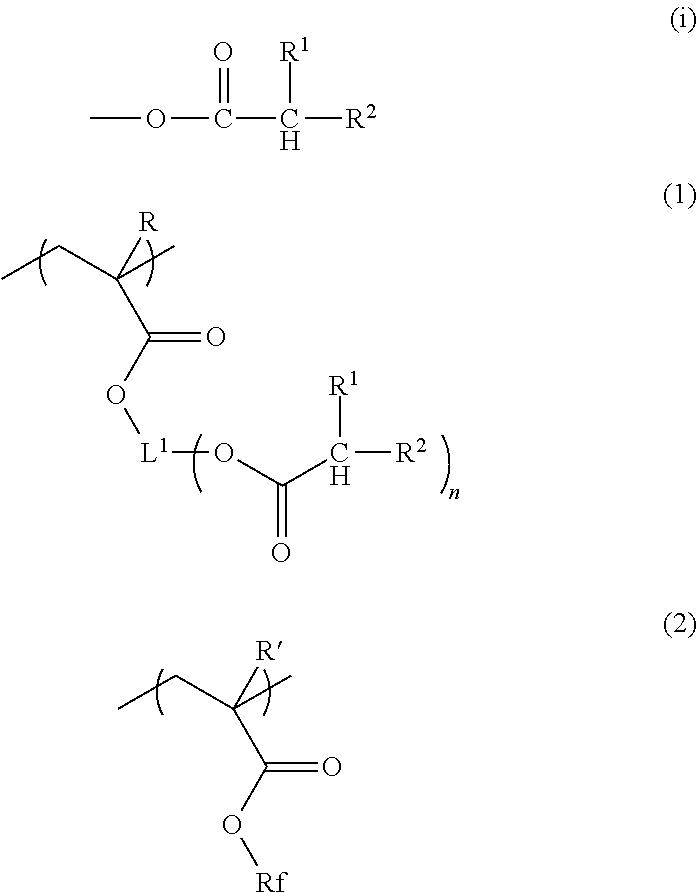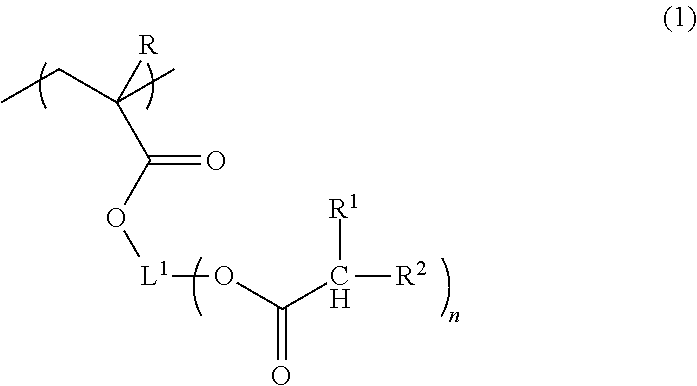Composition for forming liquid immersion upper layer film, and polymer
a technology applied in the field of composition and film, can solve the problems of resist showing defects, bridge defects, blob defects, etc., and achieve the effects of high water repellency, high solubility, and hydrophobicity of the polymer component [a]
- Summary
- Abstract
- Description
- Claims
- Application Information
AI Technical Summary
Benefits of technology
Problems solved by technology
Method used
Image
Examples
synthesis example 1
Monomer Synthesis Example 1
Synthesis of Monomer that Produces Structural Unit (1-17)
[0165]21.4 g of ethylene glycol monoacetoacetate monomethacrylate was dissolved in 200 ml of toluene. After the addition of 18.3 g of nitrogen-substituted diazabicycloundecene and 17.0 g of methyl iodide, the mixture was stirred at room temperature for 3 hours. Crystals produced in the reaction mixture were removed by filtration. After transferring the filtrate to a separating funnel, 200 ml of distilled water was added to the filtrate to wash the organic layer, and the aqueous layer was removed. After washing the organic layer with 200 ml of distilled water, the aqueous layer was removed. The resulting toluene solution was dried over anhydrous magnesium sulfate, and filtered. The filtrate was dried under reduced pressure to obtain a crude product (17 g). The crude product was purified by silica gel column chromatography (hexane / ethyl acetate=1 / 4 (volume ratio)) to obtain a monomer that produces the ...
synthesis example 2
Monomer Synthesis Example 2
Synthesis of Monomer that Produces Structural Unit (1-18)
[0167]A monomer that produces the structural unit (1-18) was synthesized in the same manner as in Monomer Synthesis Example 1, except that ethyl iodide was used instead of methyl iodide.
synthesis example 3
Monomer Synthesis Example 3
Synthesis of Monomer that Produces Structural Unit (1-23)
[0168]A monomer that produces the structural unit (1-23) was synthesized in the same manner as in Monomer Synthesis Example 1, except that acetyl chloride was used instead of methyl iodide.
PUM
| Property | Measurement | Unit |
|---|---|---|
| contact angle | aaaaa | aaaaa |
| contact angle | aaaaa | aaaaa |
| contact angle | aaaaa | aaaaa |
Abstract
Description
Claims
Application Information
 Login to View More
Login to View More - R&D
- Intellectual Property
- Life Sciences
- Materials
- Tech Scout
- Unparalleled Data Quality
- Higher Quality Content
- 60% Fewer Hallucinations
Browse by: Latest US Patents, China's latest patents, Technical Efficacy Thesaurus, Application Domain, Technology Topic, Popular Technical Reports.
© 2025 PatSnap. All rights reserved.Legal|Privacy policy|Modern Slavery Act Transparency Statement|Sitemap|About US| Contact US: help@patsnap.com



